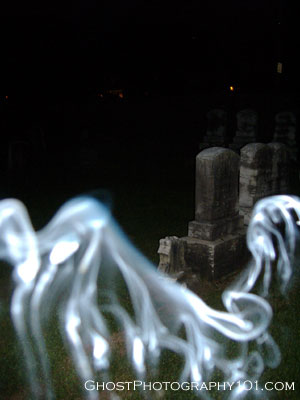As an Amazon Associate I earn from qualifying purchases. Click for details.
The following is an edited excerpt from the first edition of Ghost Photography 101, by Fiona Broome.

In the field, the word ectoplasm is often shortened to “ecto” and it’s considered rare. Ectoplasm is a complex and controversial topic.
Ectoplasm seems to be something physical. People describe it as something that’s visible to the naked eye. “Sparkles” may be small spots of ectoplasm, or they might be something different, since they don’t usually show up in photos.
Orb photos are popular and almost commonplace. Ectoplasm photos are rare and receive little attention.
In fact, many professional ghost hunters seem to dismiss all “ecto” photos as cigarette smoke. Is that fair? From my experiments, the answer is a firm “no.” It’s remarkably difficult to photograph cigarette smoke.
Like orbs, at least 90% of modern ectoplasm pictures have been taken after dark using flash cameras. To confuse matters even more, there are many natural explanations for ecto-like forms in photos.
False ectoplasm in photos
Ectoplasm in photos could be, in order of likelihood:
- Smoke.
- Breathing, fog or moisture in the air.
- An odd, reflected light.
- Hair, insects, dust or pollen.
- A camera strap.
- A light leak in a film camera.
- An error during film processing.
Let’s rule those out, if we can.
Film errors are easy to spot. Examine the film closely, looking for scratches, splashes, fingerprints or other surface evidence of mishandling during processing.
A light leak in the camera will usually extend beyond the frame of the photo, into the edges of the film.
Insects, dust and pollen usually look more like orbs. However, hair can be confusing, as can camera straps.
For reflected light to cause an ecto effect, it would have to be very close to the lens… and obvious.
Fog and drifting moisture are usually evident when the photo is taken. You can usually confirm this with a flashlight; the beam of light will highlight bands of damp air that could appear in photos.

Breathing is a problem on chilly nights. It’s easily the #1 reason someone might think “ecto” when they look at a misty photo. To rule it out, either don’t breathe (or stand close to anyone who is breathing) or don’t take ghost photos on chilly nights or when the dew point is high.
From my experiments, smoke is not likely to cause “ecto” effects. It’s possible, but not likely. (Those experiments are illustrated in the book.)
As with fog and moisture, you can usually highlight smoke with a bright flashlight, so you can tell if it’s an issue before you take photos. If its light is reflected, the smoke will reflect your camera’s flash, too.
With those factors ruled out, we’re left with another mystery: What are those eerie, misty areas and swirling entities in our photos?
Many professional ghost hunters agree that smoke is the best explanation when we see ethereal, ectoplasmic images in photographs.
Most ghost hunters insist that, even if someone had been smoking 20 minutes earlier, smoke particulate can remain in the air and reflect light, especially light from a flash camera.
If you’re serious about ghost photography and you’ve seen images that look like ectoplasm in your photos, run tests with your own cameras. Rule out normal effects, first.
I recommend testing in a variety of weather conditions, especially varying levels of humidity.
Take test photos of different kinds of smoke, including smoke from:
- Cigarettes
- Pipes
- Incense
- Burning wood (like a campfire)
- Burning paper
- Matches
If you live near a factory that spews minute particles into the air, take after-dark photos near the factory. Airports (and traffic paths of low-flying planes) can also contribute particulate matter in the environment.
It may sound like a mantra at this point, but it’s important: Always know what different normal effects look like, before deciding that you’ve photographed anything paranormal.
For locations with particulate matter in the air, check regional environmental websites. In the United States, you may find helpful information at AirNow.gov and at the EPA website, http://www.epa.gov/air/emissions/where.htm
